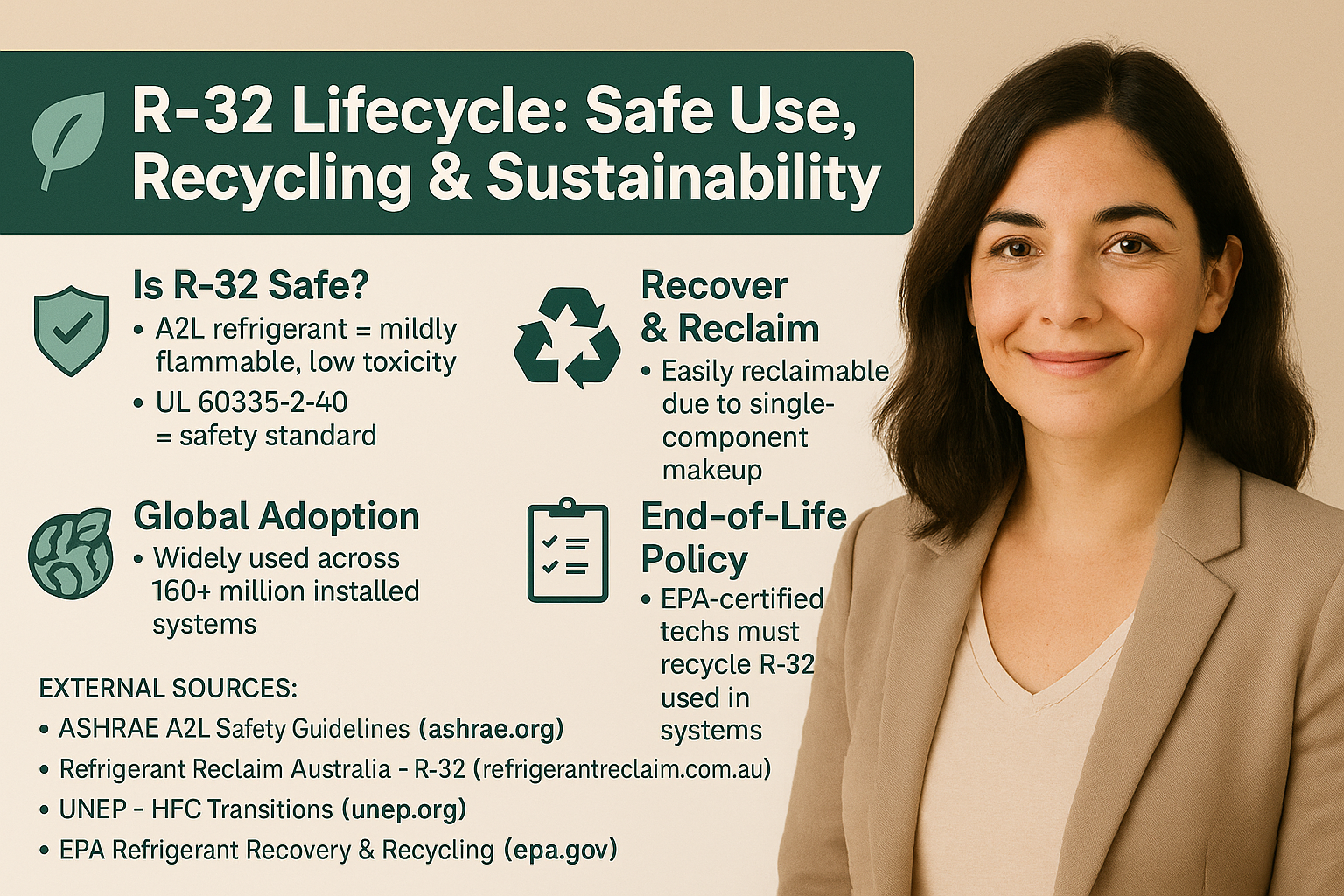Introduction
As the global community intensifies efforts to combat climate change, the HVAC industry plays a pivotal role in reducing environmental impact. A significant advancement in this arena is the adoption of R-32 refrigerant, known for its lower Global Warming Potential (GWP) and enhanced energy efficiency. This guide explores the multifaceted benefits of R-32, its safe usage, recycling practices, and its role in sustainable cooling solutions.
Understanding R-32 Refrigerant
R-32, or difluoromethane, is a hydrofluorocarbon (HFC) refrigerant widely used in air conditioning systems. It serves as a replacement for older refrigerants like R-410A due to its superior energy efficiency and lower environmental impact.
Environmental Benefits
- Lower GWP: R-32 has a GWP of 675, significantly lower than R-410A's GWP of 2,088, reducing its contribution to global warming.
- Zero Ozone Depletion Potential (ODP): Unlike some older refrigerants, R-32 does not deplete the ozone layer.
- Energy Efficiency: R-32 systems can reduce electricity consumption by up to 10% compared to systems using R-22, leading to lower carbon emissions.
"R-32 efficiently conveys heat, reducing electricity consumption and having a global warming potential that is one-third lower than R-22 and R-410A."
— Daikin Global
🔐 Is R-32 Safe for Use in Residential HVAC?
Yes—with the right protocols. R-32 is classified as an A2L refrigerant, meaning it is mildly flammable, but has a very low toxicity profile. It’s widely used across Europe and Asia with strong safety records.
Key Safety Practices:
- Only certified technicians should handle R-32
- Use spark-proof tools and UL-listed leak detectors
- Always follow UL 60335-2-40 guidelines
📘 External Source: ASHRAE A2L Safety Guidelines – ASHRAE (American Society of Heating, Refrigerating and Air-Conditioning Engineers)
♻️ Can R-32 Be Recovered and Recycled?
Yes. Unlike blends like R-410A, R-32 is a single-component refrigerant, which makes recovery, reclamation, and reuse easier and more efficient.
Recovery Advantages:
- 💡 Easier to separate and reuse
- 🚫 Lower cross-contamination risk
- ♻️ Supports refrigerant circular economy
📘 External Source: Refrigerant Reclaim Australia – R-32 Handling Guide – Refrigerant Reclaim Australia
🌐 How Widespread is R-32 Use Internationally?
R-32 has been deployed in over 160 million air conditioning systems worldwide, including residential, commercial, and light industrial applications. Many countries have begun to phase out R-410A entirely in favor of R-32 due to its 67% lower GWP.
📘 External Source: United Nations Environment Programme – HFC Transitions – UNEP (Montreal Protocol Secretariat)
🧾 End-of-Life & Environmental Policy Considerations
As R-32 becomes the dominant refrigerant, national and state-level regulations have started defining clearer recycling, storage, and disposal protocols to avoid future stockpiles or illegal venting.
- 🔒 Requires EPA Section 608 technician certification
- 🔁 Can be reclaimed and recharged into new systems
- ♻️ Subject to local refrigerant recovery laws and penalties
📘 External Source: U.S. EPA – Refrigerant Recovery & Recycling Program – U.S. Environmental Protection Agency
Safe Use of R-32
While R-32 offers environmental benefits, it is classified as an A2L refrigerant, indicating mild flammability. Proper handling and installation are essential.
Safety Considerations
- Ventilation: Ensure adequate ventilation during installation and maintenance.
- Leak Detection: Implement leak detection systems to promptly identify and address leaks.
- Professional Installation: Only certified technicians should handle R-32 systems.
"R-32 is classified as A2L (mildly flammable) under ASHRAE safety ratings. It requires proper ventilation and leak detection measures."
— The Furnace Outlet
Recycling and Reuse of R-32
Effective lifecycle management of R-32 is crucial to maximize its environmental benefits.
Recovery and Recycling
R-32's single-component nature simplifies the recovery and recycling process, promoting a circular economy.
"Recovering and reclaiming refrigerants is a key part of Lifecycle Refrigerant Management (LRM), minimizing waste and supporting a circular economy."
— Synergy Recycling
Responsible Disposal
Proper disposal of R-32 prevents environmental harm. Certified technicians should handle the disposal process to ensure compliance with regulations.
"Proper disposal and recycling of refrigerants are crucial to mitigating the environmental footprint of HVAC systems."
— Airgas Refrigerants
Sustainability and Lifecycle Management
Adopting R-32 aligns with global sustainability goals and supports the transition to eco-friendly refrigerants.
Lifecycle Refrigerant Management (LRM)
LRM encompasses the entire lifecycle of refrigerants, from production to disposal, ensuring minimal environmental impact.
"Lifecycle Refrigerant Management (LRM) is an effective and deliverable circular economy solution on the journey to net-zero."
— A-Gas
Global Adoption
R-32's adoption is accelerating worldwide, driven by environmental regulations and the push for sustainable cooling solutions.
"R-32’s combination of efficiency, serviceability, and moderate GWP makes it the dominant choice in residential and light commercial applications."
— The Furnace Outlet
Conclusion
R-32 refrigerant represents a significant step forward in sustainable cooling solutions. Its lower GWP, energy efficiency, and global adoption make it a preferred choice for eco-conscious consumers and professionals. By understanding its benefits, safety considerations, and proper lifecycle management, stakeholders can contribute to a more sustainable future in HVAC systems.
External Resources:
- Daikin Global – R-32 Benefits
- The Furnace Outlet – Safety Considerations with R-32
- Synergy Recycling – Refrigerant Disposal
- Airgas Refrigerants – Environmental Footprint
- A-Gas – Lifecycle Refrigerant Management
- The Furnace Outlet – Global Adoption Trends
If you have further questions or need assistance with specific HVAC solutions, feel free to ask!
In the next topic we will read about: Accessories and Add-Ons for Peak Performance







